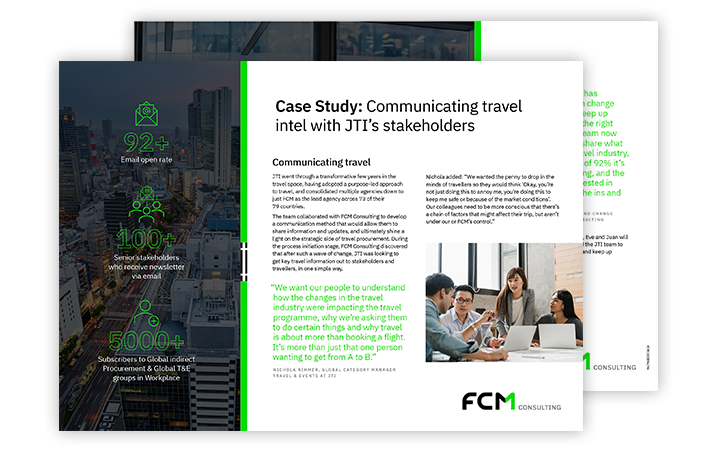CASE STUDY
Communicating travel intel with JTI’s stakeholders
Key highlights
Communicating travel
JTI went through a transformative few years in the travel space, having adopted a purpose-led approach to travel, and consolidated multiple agencies down to just FCM as the lead agency across 73 of their 79 countries.
The team collaborated with FCM Consulting to develop a communication method that would allow them to share information and updates, and ultimately shine a light on the strategic side of travel procurement. During the process initiation stage, FCM Consulting discovered that after such a wave of change, JTI was looking to get key travel information out to stakeholders and travellers, in one simple way.
“We want our people to understand how the changes in the travel industry were impacting the travel programme, why we’re asking them to do certain things and why travel is about more than booking a flight. It's more than just that one person wanting to get from A to B,” explained Nichola Rimmer, Global Category Manager Travel & Events at JTI.
Nichola added: “We wanted the penny to drop in the minds of travellers so they would think ‘Okay, you’re not just doing this to annoy me, you're doing this to keep me safe or because of the market conditions.’ Our colleagues need to be more conscious that there's a chain of factors that might affect their trip, but aren't under our or FCM’s control.”

A collaborative approach
After conducting a situation analysis to see what was available and to identify gaps, Juan Antonio Iglesias, Head of FCM Consulting EMEA set about creating a strategy to navigate this change and meet JTI’s objectives.
He recommended a quarterly newsletter packed with relevant information from various regions and departments within both FCM and JTI. Having explored other formats, Juan was confident in the tool available and the benefits it could bring to this project.
Timing is everything
While the initial plan was to release a newsletter quarterly, the team has adapted to fit wider company initiatives and avoid bombarding employees. In 2023, there will be two travel newsletters, aligned to budget cycles.
As well as emailed directly to stakeholders and directors, the newsletter is posted by the Global Indirect Procurement (GIP) network on JTI’s Workplace groups, so it’s easily accessible to everyone.
The result?
- Stakeholders are more informed than ever. There’s more awareness of the travel team and their processes, and travellers have a better understanding of what a TMC is. “It’s been cool to pull this information together to explain to travellers that this is the reality and why travel is this way,” said Nichola.
- A mindset change among JTI travellers. “When they’re going to book a trip, our travellers are remembering the information they read in the newsletter and are putting more consideration into their decisions and actions,” said Nichola.
- While the content takes time to produce, generally it is reducing the amount of ‘noise’ from travellers. “We don't have to explain everything every time,” said Nichola.
- Raised the profile of the GIP T&E team, and taken them away from operational mode into a more strategic approach.

Read the full story
When it came to implementing the newsletter and choosing the content, Nichola describes the selection and delivery as “massively collaborative.” Discover more detail about what this entailed and the type of content created.